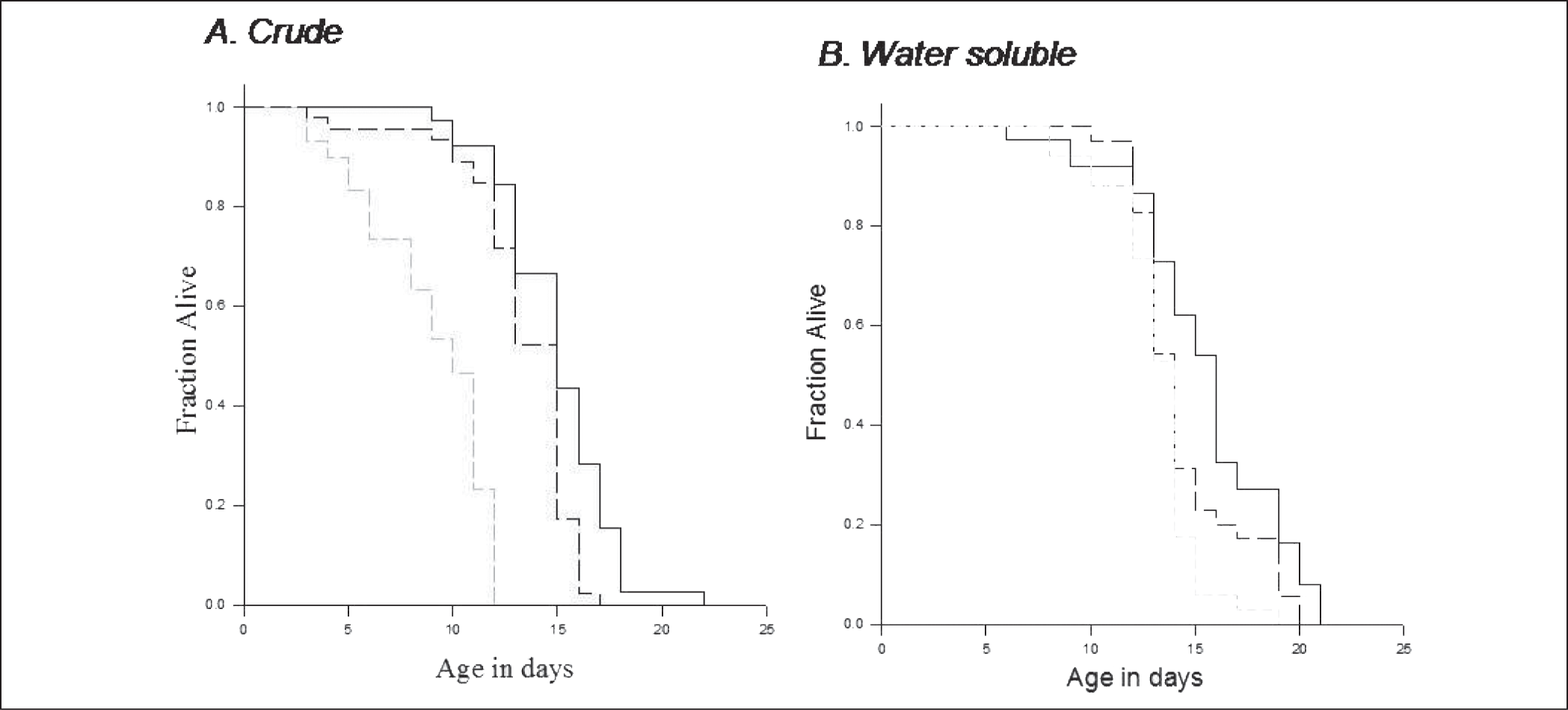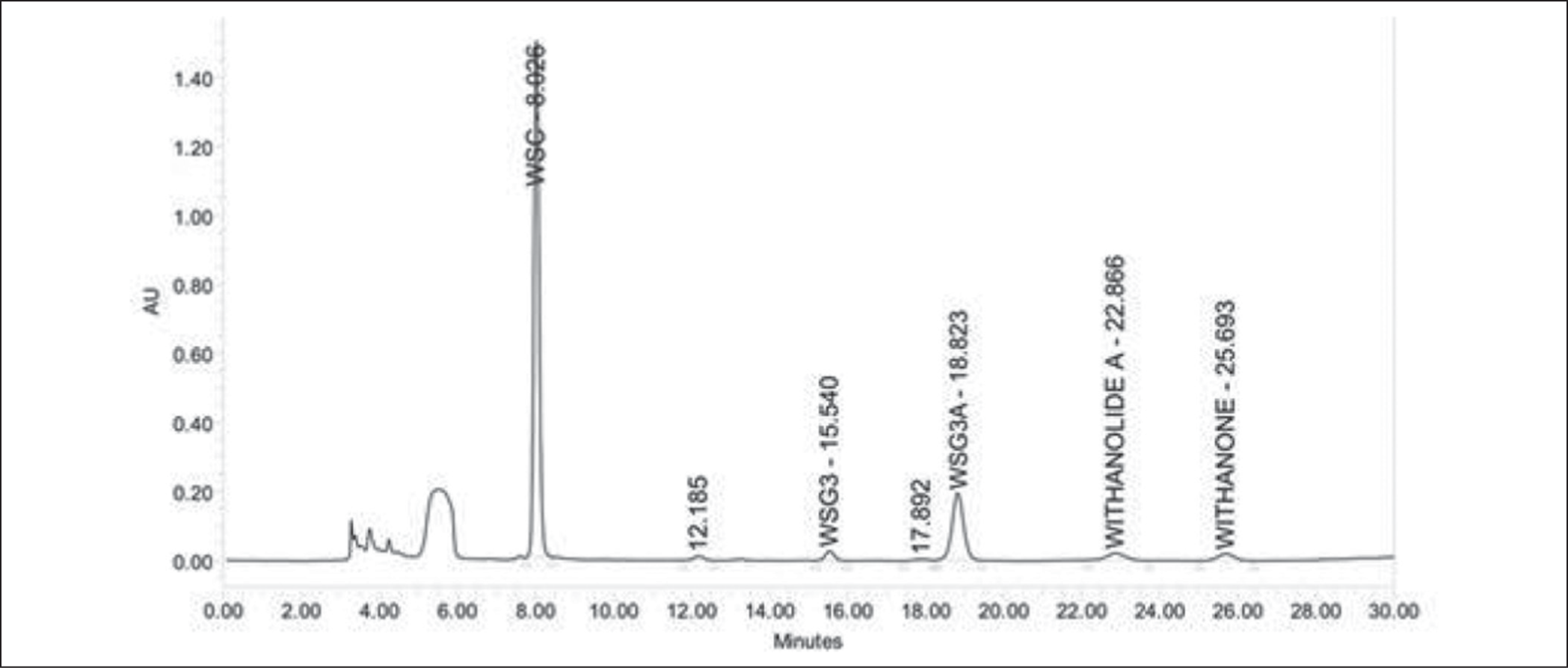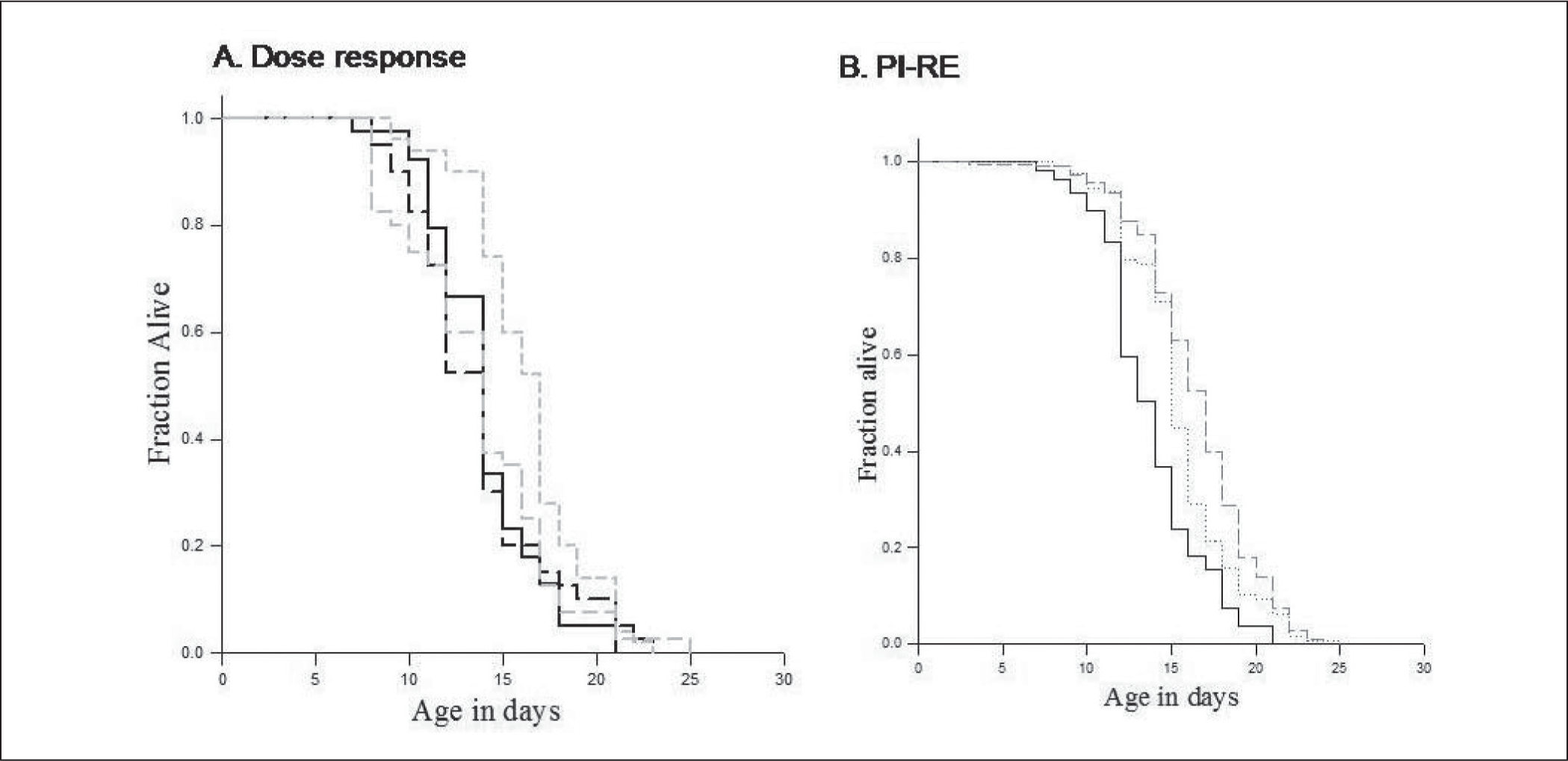
Annals of Neurosciences, Volume 20, Issue 1 (January), 2013
Withania somnifera root extract extends lifespan of Caenorhabditis elegans
KEY WORDS |
ABSTRACT |
|
C. elegans
|
Background: In the ancient Indian herbal medicine system several ayurvedic preparations are claimed to have longevity enhancing effects. But, so far, no clear scientific evidence has been provided. One among them, is the roots of the plant, commonly known as Ashwagandha (Withania somnifera Dunal- WSD), which is supposed to have myriad of beneficial effects including long life. Purpose: Here, we evaluated both the root extract (RE) and its purified ingredients (PI-RE) with a similar composition as in RE obtained from the roots of WSD for lifespan extension in the well established model system, C. elegans. PI-RE could extend the lifespan of C. elegans. Methods: We used wild type C. elegans (N2) or RB918: acr-16 (ok789); andNL2099: rrf-3 (pk1426) mutant worms and analysed their lifespan assay in Ashwagandha extract spreaded on plates containing Bacterial Lawns. Results: Strangely, while there was no effect on the wild type worms, the mutant for the human nicotinic acetylcholine receptor, nAchR, α7 equivalent, acr-16, showed around ~20% lifespan extension when treated with PI-RE. Conclusion: Thus, we are able to show that one of the age old healthy longlife supplements, Ashwagandha does extend lifespan of C. elegans. doi : 10.5214/ans.0972.7531.200106 |
|
Corresponding Author: |
Introduction
Aging is a complex, pleiotrophic phenomenon yet to be fully understood. Ever being youthful (anti-aging) and prolonged healthy living without diseases is a quest from time immemorial. Identification of long-lived mutants in C. elegans opened the avenue for healthy lifespan extension research.1–3 The major challenge with lifespan extension studies is the long time requirement (in months and years) in the mammalian systems. This could be circumvented using the versatile, seemingly simple model organism, C. elegans, which has a short lifespan (in days), but, fundamental mechanisms and systems amazingly similar to the mammalian system.4 Further, the increase in longevity mechanisms identified in C. elegans is shown to follow similar pattern in flies,5 mice6 and humans.7,8 The positive correlation between prolonged healthy long life and modulation of insulin/IGF-1 signaling was first reported from C. elegans2,3 which was later shown in flies and mice.9 The Japanese and Jewish centenarians have variants of the IGF-1 receptors.7,8 Thus, adding credence to the reduced insulin/IGF-1 signaling’s contribution to lifespan extension.10 This makes the C. elegans longevity studies more relevant. Moreover, it is less time consuming and easily amenable.4
So far, neither an innocuous longevity supplement nor a therapy to translate this longevity in humans is yet known. Recently, we reported an antihypertensive drug, reserpine, derived from the plant Rauwolfia serpentina, which is able to extend C. elegans lifespan11,12 and alleviate Amyloid β toxicity in C. Elegans.12,13 Consumption of red wine is suspected to delay aging. Later, resveratrol present in red wine is shown to extend lifespan in C. elegans14 and mice,6 and is being used as a nutritional supplement. However, this needs to be consumed in huge amounts (in gms). In the ancient Indian system, various herbal formulations have been used for thousands of years15–17 and some of them are known to have longevity effect.18 One among them is Ashwagandha – Lithuania somnifera Dunal.18 The leaf extract of WSD is shown to have anticancer effects.19 The root extract has been shown to provide antistress18 and anti-inflammatory effects19 and protection against Alzheimer’s disease20 Ashwagandhaa has minimal side effects and is in use for thousands of years.16,18 This is also implicated to have longevity enhancing effects but not clearly demonstrated.
Here in this report, we evaluated the RE extract prepared from the roots of Withania somnifera (Ixoreal Biomed Pvt Ltd, India) and the purified components in it for the effect on lifespan extension in C. elegans. We find that indeed the purified fraction can extend C. elegans lifespan.
Methods
C. elegans strains
The C. elegans wild type (N2) or RB918: acr-16 (ok789); and NL2099: rrf-3 (pk1426) mutant worms were grown on NGM plates with OP50 E. coli as food at 20°C following standard protocols.22
Preparation of Ashwagandha root extract (RE) containing plates: We followed the protocol of spreading of the RE and purified ingredients on the OP50 bacterial lawn containing NGM plates. We diluted Ashwagandha extract-RE (IXOREAL, Hyberabad, India) of various fractions: i) suspension ii) ~80% water soluble fraction iii) ~60% water soluble fraction and iv) ethanol solubilised mixture of purified components in the same ratio as in RE. The required concentration dilution was done in M9 buffer and spread on the plates containing bacterial lawn with two controls i)- no vehicle and ii) with ethanol as the vehicle.
Lifespan assays: Approximately 30–40 embryos were transferred to 35 mm plate with E. coli OP50 bacterial lawn in NGM agar with or without the compound and maintained at 25°C. The lifespan assay was carried out as described earlier11 with minor modifications. Once the worms reach the adult stage, we shift them every day to fresh plates till the end of reproduction. After that we transfer them to fresh plates every two or three days. The lifespan was counted starting L4 stage which was considered as 0. The worms which crawled off the plates were excluded. The worms were considered dead when they did not move at all to prodding with the platinum wire. We carried out the initial screening once or twice and the positive fraction assay was repeated at least two to three times. Survival Graph and statistical analyses were done using Sigmaplot 10.0. and SigmaStat 3.5.
Results and Discussion
Purified ingredients (PI) mixture of Root extract (RE) extends lifespan in C. elegans
We screened C. elegans for lifespan extension following the published protocol.11 Briefly, we treated the worms chronically with various RE and its fractions from embryo stage till death. We have screened crude (Fig. 1) and water soluble fractions of Ashwagandha (sample 1–80% water soluble and sample 2–60% water soluble) (Fig. 2) and the purified mixture with the composition (Fig. 2) as in PI-RE (Fig. 3). We carried out a dose response analysis (Fig. 3A) and found that PI-RE at a concentration of 100 ng/ml is able to extend the lifespan in the human nicotinic acetylcholine receptor α7 equivalent mutant, acr-16, but not in the wild type or another mutant which shows enhanced RNAi, rrf-3, suggesting RE can extend C. elegans lifespan in a specific background. The PI-RE treated and the control worm’s median lifespans are shown in Table. 1. PI-RE showed 21.4% lifespan extension compared to the control (NGM medium) and ~14% in comparison to the vehicle (ethanol).

Fig. 1: Evaluation of RE for lifespan extension of acr-16 mutant of C. elegans. A. Crude extract : Black line- NGM- (N = 112); Black dash- RE – 100 µg/ml (N = 131); Grey dash - and 1 mg/ml (N = 77). B. Water soluble: Black line- NGM- (N = 37); Black dash- RE (80% water soluble) – 100 µg/ml (N = 35); Grey dash RE (80% water soluble) – 100 µg/ml (N = 34).

Fig. 2: Active compounds of RE – HPLC trace.

Fig. 3: Evaluation of purified compounds mixture-PI-RE for lifespan extension of acr-16 mutant of C. elegans. A. Dose response : Black line- NGM- (N = 39); Black dash- PI-RE – 5 ng /ml (N = 40); Grey long dash - 10 ng/ml (N = 40); Grey short dash – 100 ng/ml (N = 50). B. PI-RE: Black line- NGM- (N = 109); Grey dash- Ethanol (N = 127) PI-RE 100 ng/ml (N = 213).
Table 1: PI-RE treatment extends C.elegans (acr-16 mutant) lifespan
| Sample | Median Lifespan + Std. Dev |
|---|---|
| NGM | 14 ± 3 (109) |
| NGM + ethanol | 15 ± 1.3 (127) |
| NGM + PI-KSM- 100 ng/ml | 17 ± 3.14 (213) |
It is intriguing that PI-RE did not show lifespan extension in the wildtype worms or the enhanced RNAi mutant, rrf-3, but extended the lifespan of the nAchR, α7, subunit mutant, acr-16. Despite the reports that ashwagandha is given for healthy longlife in ayurvedic medicine, there is no concrete evidence for the same. Here we show that Ashwagandha can indeed extend the lifespan of C. elegans adding credence to this report.
Various supplements and drugs are being evaluated for induction of lifespan extension in worms. Once identified in the worms, they can/are further screened in the mammalian model–mice. The search to find an ideal drug/compound, which could extend lifespan, is ongoing. Polyphenols in blueberry22 and resveratrol14 originally identified in the skin of the black grapes and reserpine from the plant Raulwolfia serpentine can extend C. elegans lifespan. Now, we find that another ayurvedically used herbal plant, Aswagandha can extend lifespan (Fig. 3B). Interestingly, the vehicle ethanol per se is able to cause marginal lifespan extension. In terms of drugs, the antiepileptic drug, trimethadione,23 the antidepressant mianserin24 and the antihypertensive drug, reserpine, extends the worm lifespan.11 In addition, Rapamycin is shown to extend lifespan in worms and mice.25 However the side effects need to be taken into consideration. Hence, it will be worthwhile to evaluate KSM-66 for longevity effects on higher animal model.
Acknowledgment
IXOREAL BioMed Pvt. Ltd for the financial support and C.elegans Stock Center, supported by National Institutes of Health, for providing the mutant strains of C.elegans.
This article complies with International Committee of Medical Journal editor’s uniform requirements for manuscript.
Competing interests: None. Source of funding: IXOREAL BioMed Pvt. Ltd
Received Date : 04 November 2012; Revised Date : 02 January 2013
Accepted Date : 16 January 2013
References
1. Friedman DB and Johnson TE. A mutation in the age-1 gene in Caenorhabditis elegans lengthens life and reduces hermaphrodite fertility. Genetics. 1988; 118(1): 75–86.
2. Kenyon C, Chang J, Gensch E, et al. A C. elegans mutant that lives twice as long as wild type. Nature. 1993; 366: 461–464.
3. Kimura KD, Tissenbaum HA, Liu Y, et al. daf-2, an insulin receptorlike gene that regulates longevity and diapause in Caenorhabditis elegans. Science. 1997; 277: 942–946.
4. Arya U, Das CK and Subramaniam JR. Caenorhabditis elegans for preclinical drug discovery. Curr Sci. 2010; 99(12): 1669–1680.
5. Hercus MJ, Loeschcke V, Rattan SI. Lifespan extension of Drosophila melanogaster through hormesis by repeated mild heat stress. Biogerontology. 2003; 4:149-156.
6. Baur JA, Pearson KJ, Price NL, et al. Resveratrol improves health and survival of mice on a high-calorie diet. Nature. 2006; 444: 337–342.
7. Kojima T, Kamei H, Aizu T., et al. Association analysis between longevity in the Japanese population and polymorphic variants of genes involved in insulin and insulin-like growth factor 1 signaling pathways. Exp Gerontol. 2004; 39: 1595–1598.
8. Suh Y, Atzmon G, Cho MO, Hwang et al. Functionally significant insulinlike growth factor I receptor mutations in centenarians. Proc. Natl Acad. Sci.USA. 2008; 105: 3438–3442.
9. Kenyon C. The plasticity of aging: insights from long-lived mutants. Cell. 2005; 120: 449–460.
10. Kenyon C. The genetics of aging. Nature. 2010; 464: 504–512.
11. Srivastava D, Arya U, Soundara Rajan T, et al. Reserpine can confer stress tolerance and lifespan extension in the nematode C. elegans. Biogerontology. 2008; 9: 309–316.
12. Saharia K, Arya U, Kumar R, et al. Reserpine Modulates Neurotransmitter Release to extend lifespan and alleviate Age-Dependent Ab Proteotoxicity. Experimental Gerontology. 2012; 47(2):188–197.
13. Arya U, Dwivedi H, Subramaniam JR, et al. Reserpine ameliorates Abeta toxicity in the Alzheimer’s disease model in C. elegans. Exp Gerontol. 2009; 44(6–7): 462–466.
14. Wood JG, Rogina B, Lavu S, et al. Sirtuin activators mimic caloric restriction and delay ageing in metazoans. Nature. 2004; 430: 686–689.
15. Singh RH, Narsimhamurthy AK, Singh G, et al. Neuronutrient impact of Ayurvedic Rasayana therapy in brain aging. Biogerontology. 2008; 9: 369–374.
16. Lele RD. Beyond reverse pharmacology: Mechanism-based screening of Ayurvedic drugs. J Ayurveda Integr Med. 2010; 1(4): 257–265.
17. Priyandoko D, Ishii T, Kaul SC, et al. Ashwagandha leaf derived withanone protects normal human cells against the toxicity of methoxyacetic acid, a major industrial metabolite. PLoSOne. 2011; 6(5): e19552.
18. Mishra LC, Singh BB, Dagenais BA, et al. Scientific basis for the use of Withania Somnifera (Ashwagandha): A Review. Alternative Medicine Review. 2000; 5(4): 334–346.
19. Malik F, Kumar A, Bhushan S, et al. Immune modulation and apoptosis induction: Two sides of antitumoural activity of a standardised herbal formulation of Withania somnifera. Eur J Cancer. 2009; 45(8): 1494–509.
20. Sehgal N, Gupta A, Valli RK, et al. Withania somnifera reverses Alzheimer’s disease pathology by enhancing low-density lipoprotein receptor-related protein in liver. Proc Natl Acad Sci USA. 2012; 109(9): 3510–3515.
21. Brenner S. The genetics of Caenorhabditis elegans. Genetics. 1974; 77: 71–94.
22. Wilson MA, Shukitt-Hale B, Kalt W, et al. Blueberry polyphenols increase lifespan and thermotolerance in Caenorhabditis elegans. Aging Cell. 2006; 5: 59–68.
23. Evason K, Huang C, Yamben I, et al. Anticonvulsant medications extend worm life-span. Science. 2005; 307: 258–62.
24. Petrascheck M, Ye X, Buck LB, et al. An antidepressant that extends lifespan in adult Caenorhabditis elegans. Nature. 2007; 450: 553–556.
25. Harrison DE, Strong R, Sharp ZD, et al. Rapamycin fed late in life extends lifespan in genetically heterogeneous mice. Nature. 2009; 460: 392–395.